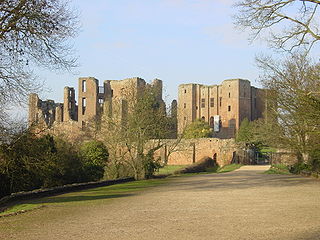
Kenilworth Castle is a castle in the town of Kenilworth in Warwickshire, England managed by English Heritage; much of it is still in ruins. The castle was founded during the Norman conquest of England; with development through to the Tudor period. It has been described by the architectural historian Anthony Emery as "the finest surviving example of a semi-royal palace of the later middle ages, significant for its scale, form and quality of workmanship".
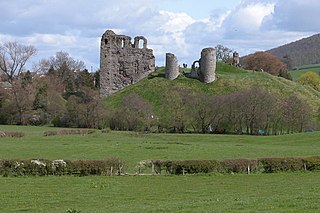
Clun Castle is a medieval ruined castle in Clun, Shropshire, England. Clun Castle was established by the Norman lord Robert de Say after the Norman invasion of England and went on to become an important Marcher lord castle in the 12th century, with an extensive castle-guard system. Owned for many years by the Fitzalan family, Clun played a key part in protecting the region from Welsh attack until it was gradually abandoned as a property in favour of the more luxurious Arundel Castle. The Fitzalans converted Clun Castle into a hunting lodge in the 14th century, complete with pleasure gardens, but by the 16th century the castle was largely ruined. Slighted in 1646 after the English Civil War, Clun remained in poor condition until renovation work in the 1890s.

Etal Castle is a ruined medieval fortification in the village of Etal, Northumberland, England. It was built around 1341 by Robert Manners, and comprised a residential tower, a gatehouse and a corner tower, protected by a curtain wall. The castle was involved both in local feuding and the border wars between England and Scotland. There was a battle between the rival Manners and Heron families outside the walls in 1428, and in 1513 it was briefly captured by King James IV of Scotland during his invasion of England.

Restormel Castle lies by the River Fowey near Lostwithiel in Cornwall, England, UK. It is one of the four chief Norman castles of Cornwall, the others being Launceston, Tintagel and Trematon. The castle is notable for its perfectly circular design. Although once a luxurious residence of the Earl of Cornwall, the castle was all but ruined by the 16th century. It was briefly reoccupied and fought over during the English Civil War but was subsequently abandoned. It is now in the care of English Heritage and open to the public.

Nunney Castle is a medieval castle at Nunney in the English county of Somerset. Built in the late 14th century by Sir John Delamare on the profits of his involvement in the Hundred Years War, the moated castle's architectural style, possibly influenced by the design of French castles, has provoked considerable academic debate. Remodelled during the late 16th century, Nunney Castle was damaged during the English Civil War and is now ruined.

Piel Castle, also known as Fouldry Castle or the Pile of Fouldray, is a castle situated on the south-eastern point of Piel Island, off the coast of the Furness Peninsula in north-west England. Built in the early-14th century by John Cockerham, the Abbot of neighbouring Furness Abbey, it was intended to oversee the trade through the local harbour and to protect against Scottish raids. The castle was built using stones from the local beach, and featured a large keep with surrounding inner and outer baileys. It was used as a base by the Yorkist pretender Lambert Simnel in 1487, but by 1534 it had fallen into ruin and passed into the hands of the Crown.
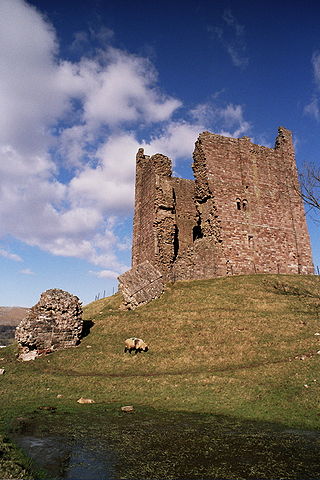
Brough Castle is a ruined castle in the village of Brough, Cumbria, England. The castle was built by William Rufus around 1092 within the old Roman fort of Verterae to protect a key route through the Pennine Mountains. The initial motte and bailey castle was attacked and destroyed by the Scots in 1174 during the Great Revolt against Henry II. Rebuilt after the war, a square keep was constructed and the rest of the castle converted to stone.
Harewood Castle is a 14th-century stone hall house and courtyard fortress, located on the Harewood Estate, Harewood, in West Yorkshire, England. Harewood Castle is a grade I listed building.

South Cowton Castle is a 15th-century fortified dwelling house in the Richmondshire district of North Yorkshire, England. It is situated on the land that was once the medieval village of South Cowton.

Longthorpe Tower is a 14th-century three-storey tower in the village of Longthorpe, famous for its well-preserved set of medieval murals.

Clifton Hall was a fortified manor house in the village of Clifton, Cumbria. Dating from around 1400, it was constructed by either Elianor Engaine or her son-in-law William Wybergh, and was held by the Wybergh family until the 19th century. Initially taking the form of an "H"-plan design built around a central hall, around 1500 a three-storey stone pele tower was added, providing both additional security and acting as a status symbol for the family. At the start of the 17th century a new stone hall was added to the south of the tower.
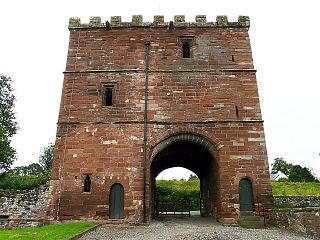
Wetheral Priory Gatehouse is a 15th-century stone fortification in Wetheral, Cumbria. The priory was founded at the start of the 12th century and the gatehouse controlled the entrance to its outer courtyard. When the priory was dissolved in 1538 the gatehouse and a nearby stretch of wall were the only parts to survive. The gatehouse passed into the control of Carlisle Cathedral and became the local vicarage during the 16th and 17th centuries, before being used to store hay. Now part of a modern farm that occupies the former priory site, it is controlled by English Heritage and open to visitors. The crenellated gatehouse has three storeys, with the main entrance and porters' lodge on the ground floor and two domestic chambers on the upper floors. English Heritage considers the building to be "the finest medieval gatehouse in Cumbria".

Dacre Castle is a moated tower house in the village of Dacre, 4 miles (6.4 km) south-west of Penrith, Cumbria, England. It was constructed in the mid-14th century, probably by Margaret Multon, against the background of the threat of Scottish invasion and raids, and was held in the Dacre family until the 17th century. The tower house is 66 feet (20 m) tall, built out of local sandstone, topped by crenellations, with four turrets protruding from a central block, and includes an ornate lavabo in the main hall. Renovated during the 1670s and 1960s after periods of disrepair, the castle is now used as a private home.

Elsdon Tower is a Grade I listed medieval tower house converted for use as a Rectory situated at Elsdon, Northumberland. Originally part of the estate of Elsdon Castle, it later become a rectory and is now a private residence. The original construction dates from the 15th century and has been modified several times.

Burneside Hall is a converted medieval pele tower in Burneside, Cumbria, England.

Branthwaite Hall is pele tower in Cumbria, England, considered by historian Anthony Emery to be "one of the best-preserved early houses in Cumbria".

Paull Holme Tower is an unusual late-medieval fortified tower in the East Riding of Yorkshire, England.

Askerton Castle is a medieval fortified manor house in Cumbria, England.

Wharton Hall in Wharton, Cumbria, England, is a medieval fortified manor house.
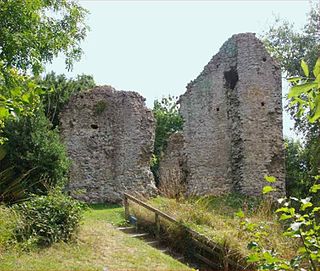
Sutton Valence Castle is a ruined medieval fortification in the village of Sutton Valence in Kent, England. Overlooking a strategic route to the coast, the original castle probably comprised an inner and an outer bailey and a protective barbican, with a three-storey high keep on its southern side.























